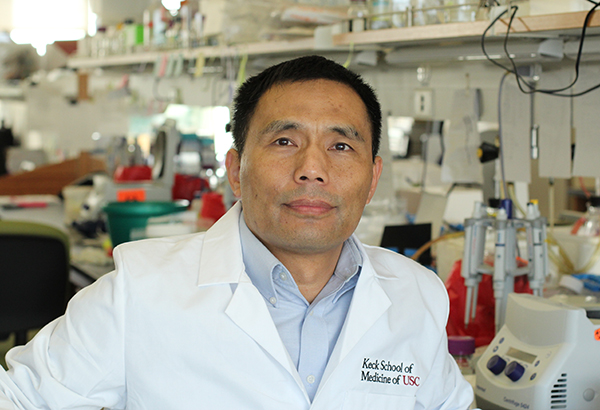
Researchers at the Keck School of Medicine of the University of Southern California (USC) have, for the first time, generated “knockout” rats—animals that are genetically modified to lack one or more genes—through embryonic stem (ES) cell-based gene targeting. The long-awaited achievement provides scientists with a far more effective animal model to study a range of human diseases.
The research was published online Aug. 11 in the journal Nature and will appear in an upcoming print edition of the journal.
“Using this gene targeting technology in ES cells, we can produce nearly any type of mutation in any given genes, allowing us to generate many different disease models for the rat,” said Qi-Long Ying, Ph.D., assistant professor of cell and neurobiology at the Keck School of Medicine of USC and the study’s principal investigator. “We anticipate that many of the rat models generated using this technology will mimic human conditions more closely, and can be used for drug screening and the testing of new treatments.”
The development of knockout rats will have a significant impact on biomedical research because the rat physiology is much more closely related to humans than mice in many aspects of biology. Also, rat models more closely mimic human diseases in many areas such as cardiovascular disease, neurodegenerative disease, nephropathy, obesity, and breast cancer.
“The ability to specifically modify rat genes to mimic human diseases, or to study how the human body responds to drugs represents a technical breakthrough of profound impact,” said Martin Pera, Ph.D., director of the Eli and Edythe Broad Center for Regenerative Medicine and Stem Cell Research at USC. “This discovery provides researchers around the world with a powerful new platform to study disease and develop new medicines. Dr. Ying and his USC colleagues aim to take the lead in disseminating this important technology to the national and international scientific community.”
Ying and his colleagues targeted genes through homologous recombination—a technique in which nucleotide sequences are exchanged to produce new combinations of DNA—in rat ES cells. Their research focused on disrupting the tumor suppressor gene p53. Mutations in this gene, which impair its function, are the most common genetic changes in human cancers. These ES cells can transmit their mutation through the germ line to create p53 gene knockout rats.
“The p53 gene knockout rats will provide a very useful model for understanding the gene’s functions in preventing the occurrence of cancers,” Ying said. “We can also use this model to test different drugs and therapies for the treatment of cancers caused by mutations in the p53 gene.”
The same technique could be used to target any gene and create models for a number of other diseases, Ying noted.
The first embryonic stem cell lines were established from mice in 1981 by Sir Martin Evans of Cardiff University, U.K and Gail Martin of the University of California, San Francisco. Evans, Mario Cappechi, and Oliver Smithies received the Nobel Prize in Physiology or Medicine in 2007 for developing methods for gene targeting using mouse embryonic stem cells. Researchers have long worked to establish rat embryonic stem cells, but they faced technical hurdles because the conventional methods developed for the derivation of mouse cells did not work in rats. In 2008, researchers at the Keck School led by Ying, and researchers at University of Cambridge, derived rat ES cells for the first time in history, determining that by blocking certain signals that would normally cause the cell to differentiate, stem cells from rats could be grown indefinitely in the lab. The finding paved the way for the team’s development of the p53 gene knockout rats.
The research was funded by a grant from the National Center for Research Resources at the National Institutes of Health.
